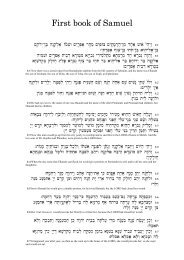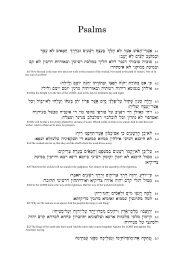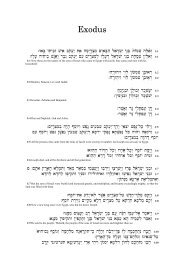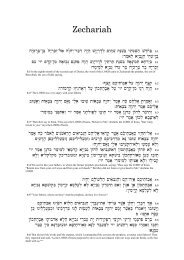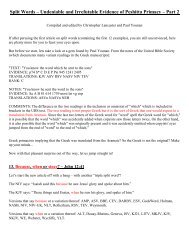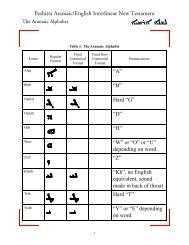ana translation
Untitled - Peshitta Aramaic/English Interlinear New Testament
Untitled - Peshitta Aramaic/English Interlinear New Testament
- No tags were found...
Create successful ePaper yourself
Turn your PDF publications into a flip-book with our unique Google optimized e-Paper software.
2 PET. m. 10] SUPPLEMENTAL NOTES. 115<br />
joins them; while 9 goes over to the graecized .3Q&^><br />
ancj 12<br />
similarly (|| a^^)- ^ tne whole number, 18 alone agrees in both<br />
places with Harkl. ;<br />
the rest in ver. 12 give fcoOQ^cbl (except 7, 8, 10,<br />
which omit). Possibly the scribes of the copies which thus vary may<br />
have intended by so doing to correct the apparently tautologous repetition<br />
in ver. 12 of the words of ver. 10.<br />
They may have meant to suggest<br />
that the oroi^eta<br />
in one place (tcODO^Cp)) were to be understood as<br />
" the heavenly bodies " (as often in Syr. ; rarely in late Gr.), while the<br />
o-roixeia<br />
in the other (U-SQ^^) were " the elements," according to the<br />
legitimate meaning of the word. But it is not to be supposed that the<br />
translator had any thought of such distinction, though<br />
it<br />
may have<br />
been introduced by his transcribers. On the whole,<br />
accept ICQDQ^SD!<br />
i*1 both verses.<br />
it seems best to<br />
Ib. All texts of Philox. here attest tvptOrjvcTai (as read by N B K P<br />
and other authorities), by rendering -KkDA1 (11, 13, 14, 20,<br />
supported by the margin of Harkl. (a),<br />
which offers it<br />
alternative for the j,jO|2 >x.ifT) of its text ( = /cara/carJcrcTai,<br />
as read<br />
by A and most Greek cursives; see notes on Syr. and Gr. texts, in loc.).<br />
But our codices, even those of the earlier group, are divided as to omitting<br />
or inserting the negative (J before the verb. For '<br />
its omission,<br />
we have 1, 2, and 12, with the later but carefully edited 7, 11, 13, reinforced<br />
by 18 and 19, and confirmed (as above) by the Harkl. note :<br />
while 9 and 14, and also 20, here siding with 3, 8, 10, Etzel, and the<br />
Polyglots, are for its insertion. But the Arab, translator by throwing<br />
his weight into the scale with 1, 2, and 12, turns the balance in favour<br />
of the affirmative reading, in agreement with the Gr. witnesses for<br />
evptOrjo-cTai, none of which prefixes to it ov^.<br />
It is to be noted that<br />
in 2 (an estrangela codex), |J is inserted (prima manu?) before the<br />
verb, in cursive character clearly by an afterthought. In 7, room<br />
seems to have been intentionally left by the scribe for like interpolation.<br />
Likewise White, in his edition of Harkl., prints a conjectural<br />
[|J] before the verb where it appears on the margin. The conclusions<br />
to which these facts lead are : that Philox. represents a Greek text<br />
which with N B, &c. (as above) read ev/ae^o-crat (without ovx) j<br />
that he<br />
rendered it *j*2A*2 accordingly, without ]] ;<br />
that the copies of his<br />
version used by Harkl. in the second decade of the seventh century,<br />
and by the Arab, translator early (probably) in the ninth, preserved



